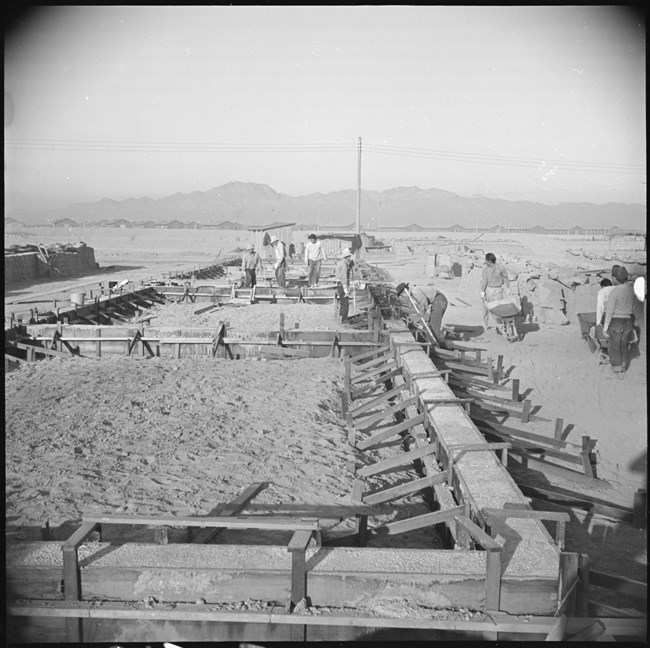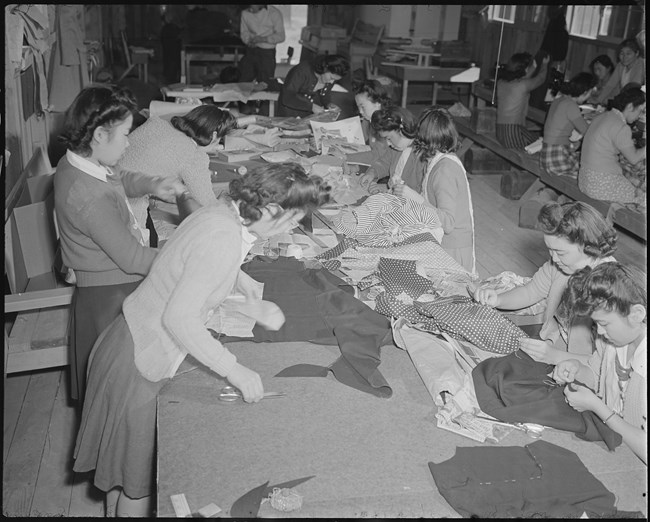Last updated: September 13, 2023
Article
Education Behind Barbed Wire
Education and learning did not stop for those imprisoned inside the Poston War Relocation Center. Opened in late 1942, the schools struggled with teacher retention and lacked basic supplies. Still students and teachers worked hard, and a few classes graduated high school while inside the camps, in 1943, ‘44, and ‘45. Some of the Japanese Americans incarcerated during their senior or junior year of high school were able to complete their degree long distance. One such person was Yone Munemitsu (née Sasaki), who graduated from her original high school, Santa Ana High, class of 1943, by taking classwork with her to do independent study while incarcerated.
Each of the three camps in Poston had its own set of elementary and middle/high schools. The Federal War Relocation Authority wrote the lessons that were taught to children inside the camp schools. As a result, the lessons had a strong emphasis on themes of loyalty and nationalism. Of all three high schools, only the high school in Camp 3 was an accredited United States high school.

Collection of the National Archives and Records Administration (NAID: 536622).
The first school year in Poston was difficult. Of the 100 teachers hired to come work in the camps, only seventy showed up. Of those seventy, only fifty-five remained by December. No school buildings were complete, so the classes were held in large drafty rooms with fabric dividers between the classes. Many of the children who graduated from high school that year felt that their chances of attending and succeeding in universities were destroyed by the chaos of adjusting to camp life. It was too difficult to try to learn while freezing in the cold winters, burning up in the hot summers, and not having enough basic resources including paper, pens, and pencils. The Japanese American incarcerees built three school campuses with an estimated 750,000 adobe bricks they made.
For the second year in Poston, a school building had been built and the teachers were a more stable presence. Still, students and teachers struggled with obtaining necessary resources to teach. To make up for this, students would often make their own learning materials such as maps, or lesson books. One student recorded in a letter back home, “We don’t have any geography books so we have to make a map of the United States. And we have to know where every state is and how to spell them.” Additionally, in an attempt to help students determined to go on to higher education after high school, a club was formed specifically aimed at getting students ready for college and moving back to broader society. Many kids were able to attend higher education once they left Poston, but due to ongoing racism they had to find colleges open to accepting Japanese Americans.

Collection of the National Archives and Records Administration (NAID: 280956934).
Unique Struggles
Very young students had no real memories about life outside of the camps. As a result, kindergarten and preschool lessons focused on trying to teach the kids what “home” is like. Some teachers built little models of houses so they could show their students what homes looked like for people who did not have to live in tiny barracks. Other times, teachers would struggle to explain to kids that leaving their house to go to the bathroom was not normal. These teachers had the extra duty of trying to prepare their young students for daily life outside of the camp.
Younger kids did not have to worry about college readiness and adult life. Many of the younger kids enjoyed their time in school, as it felt more like their old lives. Yoshiko Uchida, a teacher at Topaz Internment Camp, once battled her way through a dust storm to get to her second-grade class. She did this despite the fact that she was convinced none of her students would show up because of the weather. The class was in full attendance when she arrived.

Collection of the National Archives and Records Administration (NAID: 536648).
Education for Everyone
Adult Education Classes
There were also educational opportunities inside the camp for people regardless of age. Japanese American incarcerees organized and taught all of the classes themselves. There were lessons on things such as English, Japanese, sewing, typing, auto shop, cosmetology, tailoring, and more. Language classes were made to help connect those within the camp. There were English classes for the older generations and more recent immigrants as well as Japanese classes for the younger Nisei, second-generation Americans who used English as their main language. Other classes, such as cosmetology or tailoring, were intended to help them rebuild their lives after the war ended.
Indefinite Leave
Beyond these classes inside Poston, there was also the option of “indefinite leave" which allowed young adults to leave the camp to pursue higher education. This option had its own challenges though. Young Japanese Americans were not allowed to return to the west coast where they had lived before being imprisoned. This meant they would have to move somewhere new, where they did not have any friends or family.
Additionally, most people who were in the camps had most of their resources taken away from them. They did not have much money to fund an education. Young adults were sent out into the world hoping they would be able to find someone to support them. Support could come through substantial scholarships, or a family willing to take them in. Additionally, many schools refused to accept students of Japanese descent. Therefore, Japanese American students had to apply to many different schools before they found one willing to give them a chance. Towards the end of war, the option of “indefinite leave” was extended to high schoolers as well.
Babe Karasawa, a former detainee at Poston, recalls this experience:
"I left Poston October 3, 1944, to Woodstock, Illinois, to finish high school - my senior year. When I left, one of our teachers, the public-speaking teacher, Miss Ellis, who had just graduated from the University of Illinois, said, "Babe, you are going to the best prep school in the state of Illinois!" It was perfect for me! There were two of us- the other kid came from Topaz- and we were able to go to the Todd School for Boys. My folks worked in the school and I worked in the kitchen. It was a prep school for rich kids. Grades 1-12. I even have a copy of the letter that says my scholarship was for $1,200! That was a lot of money in 1944! They treated me so nicely. Even in the town, a town of 2,500 people… when I walked into the town square, everyone was watching me. They saw me face to face–everyone had a smile. I didn't run into any animosity."
This article was researched and written by Alyssa Eveland, Telling All Americans' Stories Fellow, Cultural Resources Office of Interpretation and Education.
Poston Adult and Vocational Training Education Department. The Light of Learning. Poston, AZ: Poston War Relocation Center, 1945. Gerth Archives and Special Collections, California State University, Sacramento. https://cdm16855.contentdm.oclc.org/digital/collection/p16855coll4/id/10685.
Munemitsu, Janice. The Kindness of Color: The Story of Two Families and Mendez, et al. v. Westminster, the 1947 Desegregation of California Public Schools. Foreword by Sylvia Mendez. Self-published, Janice Munemitsu, 2021.
National Park Service. “Poston Elementary School, Unit 1, Colorado River Relocation Center.” Place. March 11, 2019. https://www.nps.gov/places/colorado-river-relocation-center.htm.
Oppenheim, Joanne. Dear Miss Breed: True Stories of the Japanese American Incarceration During World War II and a Librarian who Made a Difference. Foreword by Elizabeth Kikuchi Yamada. New York: Scholastic, 2006.
Tunnell, Michael O. Desert Diary: Japanese American Kids Behind Barbed Wire. Charlesbridge Publishing Inc., 2020.
